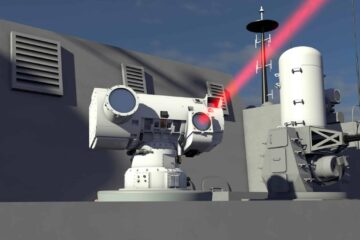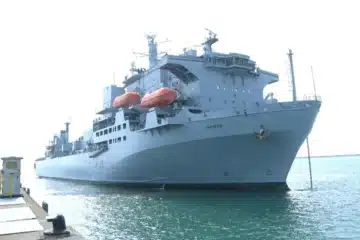Royal Navy press release
Fresh from training alongside UK F-35B Lightning jets, HMS Prince of Wales, which is NATO’s command ship, sailed north for Exercise Cold Response, a month-long test by land, sea and air of allied forces which will see 30,000 troops from 27 nations operate together in one of the world’s harshest environments.
A task force of 25 ships from 11 nations gathered off the Norwegian coast at the start of the training, which will show how a unified force would defend Norway and Europe’s northern flank from a modern adversary.
HMS Prince of Wales joined the Cold Response task force shortly after air defence exercises in the North Sea alongside four of the UK’s F-35B Lightning jets from 617 Squadron, the Dambusters.

The jets from RAF Marham took part in an air battle, which were orchestrated by two Royal Navy fighter controllers on HMS Prince of Wales in the skies over the east of the UK and in the North Sea.
“It’s a really exciting position to be the link between the jets and the ship,” said controller Lieutenant Si Clark. “Although we don’t have them currently embarked, being able to control the jets during their training is a really rewarding role on HMS Prince of Wales.”
The F-35B jets were pitted against eight ‘aggressor’ aircraft, allowing them to hone tactics between ship and fighter jets. Typhoon jets were also involved as well as Hawks from 100 Squadron at RAF Leeming.
As Prince of Wales continued her journey north to the Arctic, the RAF’s 207 Squadron carried out a flypast with two of their F-35B jets while the aircraft carrier sailed alongside USS Mount Whitney and USS The Sullivans.
“Today was a fantastic opportunity to exercise with HMS Prince of Wales testing out our air-maritime integration tactics as well as 5th and 4th Generation integration between Lightning and Typhoon. Having spent seven months with HMS Queen Elizabeth on Carrier Strike Group 21, it was great for 617 Squadron to be able to work with HMS Prince of Wales for the first time as she hones her skills as a command ship for NATO. The air defence exercise was a great success proving the interoperability between air and sea.”
Commander Mark Sparrow Royal Navy, Officer Commanding 617 Squadron
Prince of Wales is responsible for leading NATO’s Maritime High Readiness Force – an international task group formed to deal with major global events – and deploys for the first time in that role to Cold Response.
Aboard the carrier are the most senior sea-going staff in the Royal Navy – Commander UK Strike Force, headed by Rear Admiral Mike Utley, who will lead a sizeable task force as part of a galvanized NATO effort for peace and stability in Europe.
Alongside landing support ship RFA Mounts Bay, HMS Albion leads the UK’s amphibious input into Cold Response, with “a significant level” of littoral strike operations – traditional-style commando raids – staged in the fjords, with the British force integrating with numerous allies.
Around 900 Royal Marines have been deployed to the Arctic since January in preparation for the exercises, sharpening their expertise in operating in freezing conditions.
While Prince of Wales works on Cold Response, her sister ship HMS Queen Elizabeth is carrying out vital training and exercises in the waters close to the UK to keep her ready for operations anywhere in the world.
The ships of the Cold Response task group

Surface Group: HMS Prince of Wales, HMS Defender, HMS Northumberland, RFA Tidesurge, USS Roosevelt.
SNMCMG1 (Standing Nato Mine Counter-Measures Group 1): HMS Grimsby, LVNS Virsaitis, BNS Lobelia, FGS Bad Bevensen, HNLMS Schiedam, HNoMS Magnus Lagaboete, HNoMS Olav Tryggvason, HDMS Vaedderen, HNoMS Hinnoey, ENS Sakala.
Amphibious Task Force: ITS Garibaldi, FS Dixmude, HNLMS Rotterdam, HMS Albion, RFA Mounts Bay, HNLMS Van Amstel, HDMS Peter Willemoes, FGS Berlin, HNLMS De Zeven Provincien, FS Languedoc






